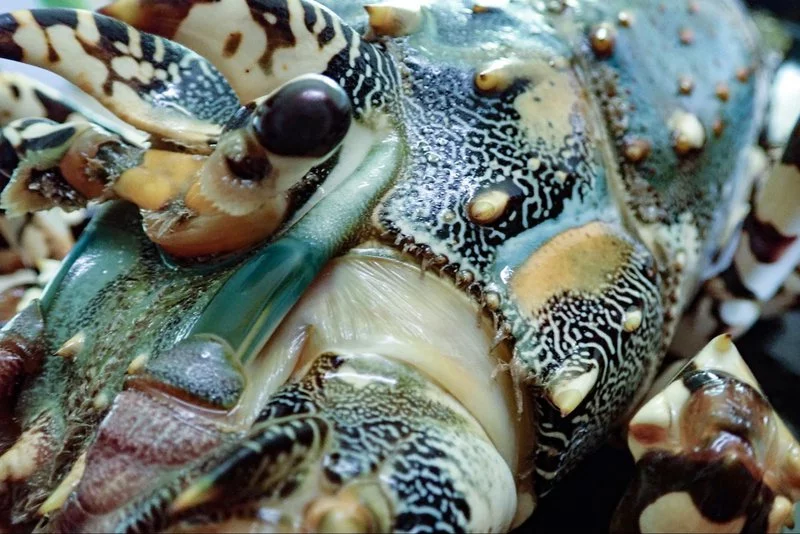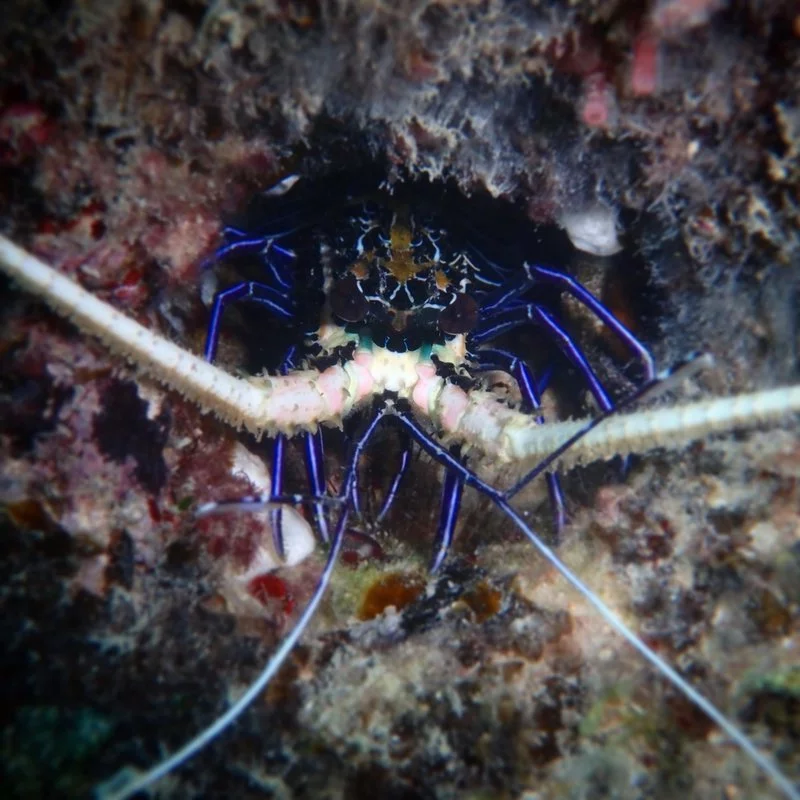Spiny Rock Lobsters or crayfish as they are known in Australia, are a family of crustaceans consisting of about 60 species. Although they are called lobsters and have a similar appearance they are not closely related to the true lobsters and have a few distinguishing features. First and foremost is the lack of claws on the spiny rock lobsters and also the long thick spiny antennae which the true lobsters lack. Around the world species of spiny rock lobster are highly sought after and are considered excellent eating. Due to their lack of claws which are handy for defence against predators the spiny rock lobsters are, as their name suggests, covered in spines. Another defence that the spiny rock lobsters employ is the loud screeching sound they can produce by rubbing their long antennae against their carapace. In Australia there is a range of different species in both our cooler southern waters and the warm tropical waters of the northern regions. The Whitsundays, being a tropical region, is home to two species of tropical rock lobster, the ornate rock lobster and the painted rock lobster. At first glance both of these species look quite similar with bright colours and intricate patterning, however if you look closely they do have some differences.
The ornate rock lobster, Panulirus ornatus, has a wide distribution across the Indo-Pacific from South Africa across to Fiji. They are found on shallow rocky and coral reefs living in crevices and overhangs, they can also be found in deeper oceanic waters at depths over 200m. The painted rock lobster, Panulirus versicolor, has a similar distribution and also prefers to live in the same habitats as its ornate cousin. Here in Australia on the east coast tropical rock lobsters can be found all along the length of the Great Barrier Reef and even as far down as Sydney, although this is not common.
As mentioned above both of these species are brightly coloured and beautifully patterned. The painted rock lobster has a green carapace with black and white patterning, the antennae are white and have a pink base and its legs, perhaps the easiest feature to tell it apart from the ornate rock lobster, are dark blue/black with vertical white stripes running down their length. Ornate rock lobsters have white legs with black bands, the carapace can be a bluish green to purple colour with intricate black and white patterning around the horns and eyes, with a green tail. They both also grow to a similar size however the ornate is slightly larger and can reach 50 centimetres in length while the painted rock lobster usually reaches about 40 centimetres. To reach these adult sizes the lobster has to go through a number of moults, usually once a year. When they moult the hard carapace is shed to reveal the new, larger carapace underneath. This new carapace will remain soft for a number of weeks until it has completely expanded and hardened and the lobster will be quite vulnerable during this time.

Spiny rock lobsters start their lives out very differently than they way they live and appear as adults. During mating an adult male attaches a packet of sperm or spermatophoric mass, often called a tar spot, to the females underside. The female will then keep this tar spot intact until she is ready to fertilise her eggs, of which there can be hundreds of thousands. Once she is ready she will simultaneously release her eggs and the sperm from the tar spot by scratching it. The eggs are fertilised and as they float backwards they become attached to the fine hairs on the swimmerets under the females tail. Once the eggs hatch tiny larval rock lobsters are released into the ocean. These larvae called phyllosoma are microscopic in size and look quite different to their adult form. They will spend around 11-24 months as plankton floating around with the oceans currents and during this time they will undergo a series of moults before they reach the last larval stage called puerulus larvae. The puerulus larvae resemble adult lobsters however they are transparent and are still planktonic, living in the water column. They will swim into coastal reef areas in search of reef habitat to live on, which only a small number live long enough to do. Once they have settled on a suitable reef they will go through another moult and develop the colour of the juvenile stage. The lobsters then continue to grow and moult throughout their life, which can be up to 20 years.

The numerous reefs with an abundance of hiding places makes the Whitsundays the perfect place for these tropical rock lobster species. However they are nocturnal which means they are active at night and during the day they will spend their time hiding in the caves and crevices on the reef. This means that to spot them on your snorkels you will have to pay extra close attention and swim down to look inside all the potential hiding holes on the reef, usually all you will see are their two long antennae protruding from the hole. These guys also rarely enter baited pots so if you are looking to catch one for a tasty feed, free diving and catching them with a gloved hand will be your best chance of success.



